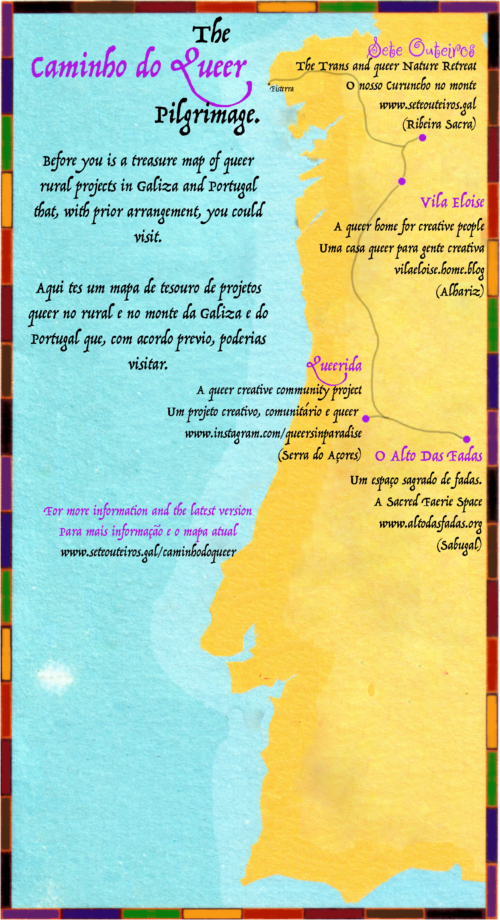PROJECTS LISTED ON THE MAP:
Sete Outeiros: You’re already on our webpage! We made this map to weave a closer queer web in this part of the world and to give you inspiritation and information for your journey!
Já estás no nosso sitio de web! Figemos este mapa para ajudar tecer umha teia queer nesta parte do mundo e dar che inspiraçao e informaçao para o teu caminho.
Vila Liberdade: Vila Liberdade (formerly called Vila Eloise) is a queer house in a small village intended as a creative and resting space, inclusive and open to queer people of any gender identity or orientation. Our artistic work space is under construction and will have a spacious workshop equiped mainly for painting and photography, although other kinds of creative work are possible too. Hosting is for free, but we accept some help with home improvement works, always within each one’s ability. vilaeloise@protonmail.com https://vilaliberdade.home.blog
Queerida: Um projeto comunitário rural criativo para queers e aliados/A rural creative community project for queers and allies. http://www.instagram.com/queersinparadise
Frequently Asked Questions:
Why Galiza and Portugal?
This map mirrors the Caminho de Portugal which starts in the south of Portugal and ends in Galiza (see why Fisterra below to read about the caminho’s destination). Though it hasn’t completely filtered down to popular cultural knowledge the language used in Galiza and Portugal is accepted by most linguists to be the same language, though with strong dialectical differences. In fact, the Portuguese of the North of Portugal still spoken by the older generation is almost identical to Galego (Galizan). The dialectical differences are strong though between North and South, though it’s not much different to someone from Mississippi struggling through a conversation with someone from Glasgow in Scotland. This pilgrimage route offers the traveller an opportunity to deepen their knowledge of galego-português in its rich linguistic and cultural diversity while travelling towards an ancient destination (again, see below).
Is the map geographically accurate?
ABSOLUTELY NOT! The locations of the projects are wildly erroneous and only intended to give you the roughest of ideas when planning your travels or visits. Contact each project you want to visit to find out where it is and how to get there.
Why Queer?
Finding a word that includes all of the people we want to include while not jarring anyone is an almost impossible task. Queer here acts not only as an umbrella term for people who are not heterosexual or not cisgender but also presents an attitude of that which cannot easily be assimilated into a mainstream culture which insists on accepting or tolerating some (handsome white gay men with middle class jobs) while rejecting others (like trans women of colour, poor queer people, muslim queers, etc.) Queer is correctly uncomfortable. Queer niggles and provokes and demands change, demands a future liberty which we should never forget that we have not yet attained. Until all are free, no one is free.
Caminho?
Caminho just means path or way. It is, in this context, the queer pilgrim’s path.
Why does the caminho go to Fisterra?
These days in popular culture many people know of the Caminho de Santiago that ends at the cathedral in Santiago de Compostela, but that Caminho is nothing more than an appropriation by the Catholic Church of a much more ancient path that people have been following for thousands of years. The original Celtic Caminho led to Fisterra, or Land’s End. The sun sets in the West and so the westmost point of the European landmass was a point of spiritual journey — a poignant place where we become aware of the end of all things, the setting of the sun and the setting of our own lives, never forgetting that the sun rises again. The Celtic peoples also believe in reincarnation. This map is made with love to provide information and inspiration to queer pilgrims who may wish to continue their journey to the ends of the land.

